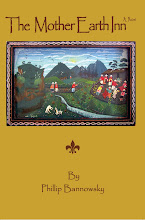One magical thing any kind of artwork does is to serve to mythologize place. Locally, for example, the Brandywine Tradition artists have provided a second sight of the countryside just north of Delaware's border allowing us to see the Brandywine Valley through their artistic sensibilities. We are fortunate to have these art works with us, which preserve this transformative vision of our local mythology for our community. Both literature and visual art have served to provide greater significance regarding place as well as for their accompanying time frames, freezing them within our imagination. However, there are comparable examples from local literature that are obscured by their relative unavailability. Re-acquainting ourselves with our local literature can be quite rewarding because of its transformative social and cultural value. However, we don't always need to find this process in literature from local authors, even if their books had once entered the national literary arena. Occasionally a long out-of-print and nearly forgotten novel provides a true story enhanced by the vision of a literary artist, as well as a true story about other literary artists who once lived among us in an unique place; that unique place is a town in northern Delaware called Arden.
For a period of time, in the years before World War I, the American author Upton Sinclair lived in Arden. He used the proceeds from his novel, Love's Pilgrimage, to build a house that still stands there. The work of American poet Harry Kemp attracted Sinclair, who invited Kemp to come and live for a spell. Kemp, who was Sinclair's contemporary, was known as a "tramp" poet. Kemp rode the rails in his day, hanging out with the "Wobblies," or members of the Industrial Workers of the World (IWW), and transforming his own vision of working and struggling against economic poverty in America into his poetry.
In 1922, Kemp published his novel, Tramping on Life, which is actually a roman-a-clef about his travels. The novel includes the episode of his life in Arden, which he calls "Eden," and his interaction with Sinclair, who becomes "Penton Baxter" and wife Meta, or "Hildreth Baxter." Incidentally, Arden's founder Frank Stephens becomes "Alfred Grahame" in Kemp's novel.
The philosophy behind Sinclair's novel, Love's Pilgrimage, in part a tome to the notion of "free love," was put to the test in Arden, and to make a long story short, Kemp, or "John Gregory" as he refers to himself, ends his visit with Sinclair by running off to New York with Sinclair's wife Meta in a blatant exercise in "free love." In New York they join that community of pre-World War I progressives made up of Emma Goldman (Emma Silverman), Lincoln Steffins (Carruthers Nefflin), John Reed, Louise Bryant, Eugene O'Neill and Djuna Barnes, among others.
I don't know about anyone else, but every time I visit Wilmington I'm fully aware that I walk the same streets that once Edgar Allan Poe and F. Scott Fitzgerald walked. It's as if I share a tiny bit in common with these venerable literary figures. They are not the only ones. There are others, like Kemp and Sinclair, who have seen and transformed this place where I live into their own visions that augment the annals of American literature for the greater fulfillment of American culture. When I read the works of those who also took up space in this place I call home, I have a better idea of how to look at my surroundings today, and, as spooky as it sounds, I wonder how closely what they felt about what they saw resembles how I see and feel about what I see here every day.






Actually it is the Industrial Workers of the World, not the International Workers of the World. Excellent information, thanks.
ReplyDeleteThanks, anonymous,
ReplyDeleteI corrected the glitch.
Administrator